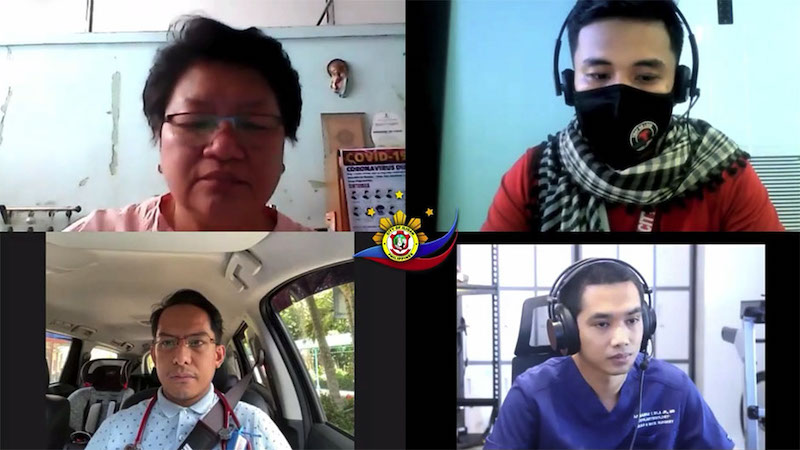ILIGAN CITY (MindaNews / 24 April) – The coronavirus disease (COVID-19) variant first detected in the Central Visayas region, officially designated as “Lineage P.3,” has reached Mindanao, with three cases so far detected in this city.
Dr. Belinda C. Lim, acting city health officer and manager of the Emergency Operations Center (EOC) Health Cluster that is focusing on the local COVID-19 crisis, announced in an online forum on Friday that the three cases were among the samples submitted to the Research Institute for Tropical Medicine (RITM) in Metro Manila on March 22 but results came back only on April 21.
She said during a Facebook Live briefer hosted by the city government on Tuesday that there has been a “surge” of COVID-19 cases in Iligan lately.
 Dr. Belinda C. Lim (top left), acting city health officer and manager of the Emergency Operations Center (EOC) Health Cluster that is focusing on the local COVID-19 crisis; Infectious Disease specialist Leonell Albert Quitos (bottom left); and Iligan Medical Society President Armando Isla Jr. (bottom right) during an online forum hosted by the Iligan City LGU.
Dr. Belinda C. Lim (top left), acting city health officer and manager of the Emergency Operations Center (EOC) Health Cluster that is focusing on the local COVID-19 crisis; Infectious Disease specialist Leonell Albert Quitos (bottom left); and Iligan Medical Society President Armando Isla Jr. (bottom right) during an online forum hosted by the Iligan City LGU.
As of Friday, Iligan recorded 1,532 total confirmed cases, 91 of which are still active. There have been 92 deaths against 1,349 recoveries, data released by the EOC said.
The “Lineage P.3” variant was first announced on March 10 by the University of the Philippines – Philippine Genome Center (PGC) from severe acute respiratory syndrome coronavirus 2 (SARS-CoV-2, the virus that causes COVID-19, from samples taken earlier, mostly from Central Visayas.
“Interestingly, the recorded collection dates of these samples coincide with a sharp increase in the number of SARS-CoV-2 infections registered in the said region,” the PGC said on its website.
The Department of Health (DOH), in a press statement posted on its website on April 18, stressed that the P.3 variant “is still NOT identified as a variant of concern (VOC) since current data is insufficient to determine whether the variant will have significant public health implications.”
Dr. Leonell Albert Quitos, Iligan’s lone infectious disease specialist, said during the Facebook Live briefer that the P.3 variant is still being investigated.
He nevertheless advised Iliganons to take the new variant seriously, considering that the three other variants already detected in the Philippines – those from the United Kingdom, Brazil and South Africa – have shown to be more infectious and caused more deaths.
He added that the vaccines have also shown to be less effective against these three variants.
Quitos noted that the three P.3 cases in Iligan have no travel histories. “So it’s most likely that they were infected locally,” he added.
Lim reminded Iliganons to continue following the best known measures to prevent contracting the virus – the DOH’s BIDA campaign, short for “Bawal walang mask; I-sanitize ang mga kamay, iwas-hawak sa mga bagay; Dumistansya ng isang metro; Alamin ang totong impormasyon.”
“These are supposed to be very simple measures, but we seem to have difficulty following them,” she lamented.
Dr. Armando Isla Jr., president of the Iligan Medical Society, warned Iliganons to be more careful because of the locality’s high COVID-19 mortality rate.
“Our mortality rate in Iligan hovers around six percent, yet the national average is under two percent,” he stressed. “That alone should be reason for Iliganons to be really careful, because we are among areas with the highest mortality rates,” Isla said.
He warned, too, that more evidences have surfaced reinforcing the notion that COVID-19 can be spread airborne. “Please avoid crowded places and enclosed spaces without proper ventilation,” he advised. (Bobby Timonera / MindaNews)
